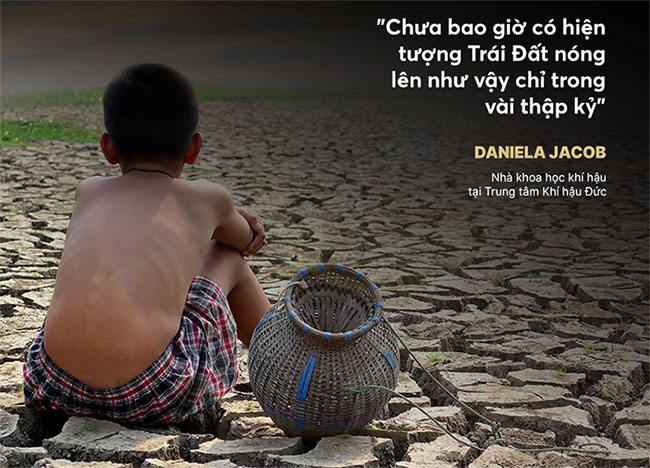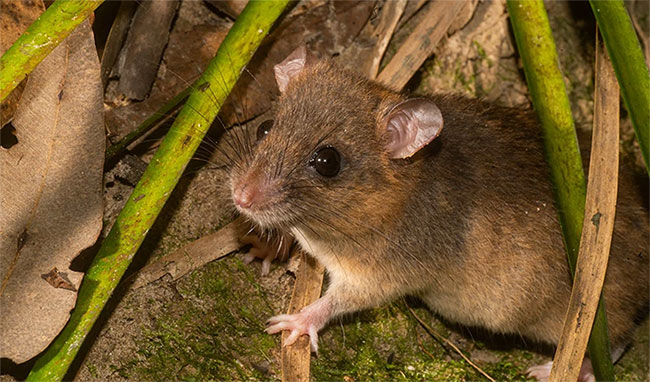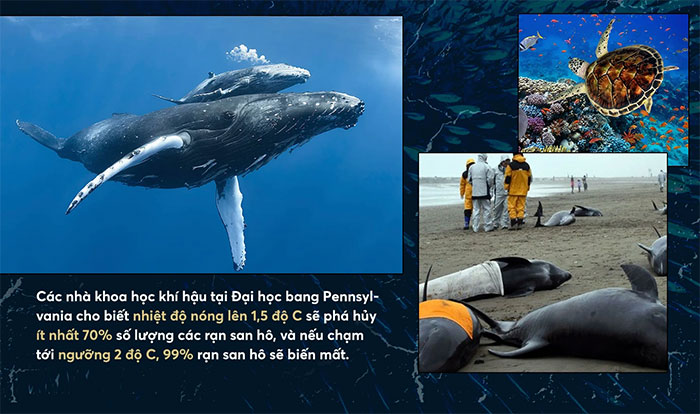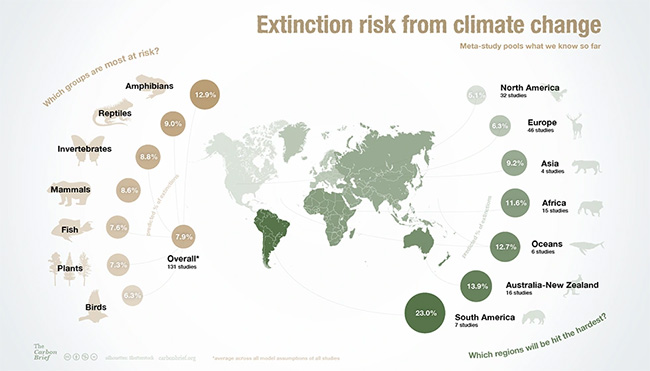Air pollution, dust, and heat… make us uncomfortable and life inconvenient. However, animal species are suffering even more. Many species are facing threats to their food sources, shrinking habitats, and declining populations. Some have gone extinct.
1 Degree Celsius and Its Terrible Impacts on the Biosphere
According to statistics from the International Union for Conservation of Nature (IUCN), the global average temperature has risen by approximately 1.1 degrees Celsius since pre-industrial times due to human activities. Each decade over the past four decades has been warmer than the previous one since 1850.
At the COP26 United Nations conference, world leaders emphasized that a temperature rise exceeding 1.5 degrees Celsius and beyond would lead to uncontrollable conditions, exacerbating extreme weather events and threatening the entire biosphere on Earth.
Meanwhile, environmental scientists agree that surpassing the 1.5 degrees Celsius threshold poses a risk of causing far more severe climate change impacts on humans, wildlife, and ecosystems.

Chart showing the annual increase in Earth’s temperature.
Daniela Jacob, a climate scientist at the German Climate Center, stated that Earth has never experienced such conditions, and everything is becoming even harsher than before.
“There has never been a global warming phenomenon like this in just a few decades,” Jacob emphasized. “This makes weather more extreme and potentially more frequent and intense.”
The difference between 1.5 degrees Celsius and 2 degrees Celsius is also considered critical for the oceans and Earth’s ice regions. Michael Mann, a scientist from Pennsylvania State University, stated that if the temperature is maintained at a 1.5 degrees Celsius increase, humans can still prevent most of the ice in Greenland and West Antarctica from collapsing.

Of course, this would help limit sea level rise to 60 cm by the end of the 21st century, although this remains a significant change that could erode coastlines and inundate some small island nations and coastal cities.
However, if the increase exceeds 2 degrees Celsius, ice sheets could collapse completely, leading to a sea level rise of up to 10 meters.
In 2021, the International Energy Agency (IEA) stated that commitments made at the COP26 conference affirmed that member countries would strive to keep the temperature rise below 1.8 degrees Celsius.
However, scenarios of a warmer Earth exceeding 2 degrees Celsius, or even 3 degrees Celsius, have been considered by scientists.
Accordingly, if the temperature rises by 2.7 degrees Celsius, it would bring about “an unlivable hot season” across tropical and subtropical regions. Alongside this, biodiversity would be severely depleted, food security would diminish significantly, and extreme weather would exceed the coping capacity of most urban infrastructure.
According to the International Fund for Animal Welfare (IFAW), the most significant threats posed by climate change to wildlife include habitat loss and escalating conflicts between humans and animals.
And of course, many animal species will face an inevitable consequence – extinction, if we do not intervene in time.
Many Animal Species Join the List of Threatened Species
Species are currently being affected by climate change caused by human activities, and its rapid onset is limiting the adaptability of many species to their environments.
According to IUCN, climate change is currently impacting at least 10,967 threatened species on the Red List, increasing their risk of extinction.
In 2019, Melomys rubicola – a rodent species, became the first mammal reported to have gone extinct due to the direct consequences of climate change.

Melomys rubicola – the first mammal reported to have gone extinct (Photo: Nature).
Previously, individuals of this species were only found on Bramble Cay in the Great Barrier Reef. However, its habitat has been completely destroyed due to rising sea levels, primarily caused by melting ice in the polar regions.
Melting ice also puts cold-adapted species in a precarious situation. In the Arctic alone, up to 17 species are facing the threat of extinction. In addition to the polar bear (Ursus maritimus), a “familiar” victim for decades, many other animal groups in this region are also facing the same fate, from plankton to various whale species.
Recently, the Emperor Penguin (Aptenodytes forsteri) has been added to the list of threatened species. According to the U.S. Fish and Wildlife Service (USFWS), due to the impacts of climate change leading to loss of sea ice, the population of this bird species is warned to decrease by “a significant portion” in the near future, specifically about 26% by 2050. However, this figure could increase to 50% if carbon emissions remain excessively high.
In the worst-case scenario, 98% of the Emperor Penguin population could disappear by 2100, making recovery efforts extremely difficult, if not impossible.
At the seabed, coral reefs, which used to be one of the most biologically diverse ecosystems, are now the fastest-declining group of species due to “mass bleaching,” disease, and rising ocean temperatures.
Climate scientists at Pennsylvania State University have indicated that a 1.5 degrees Celsius increase will destroy at least 70% of coral reefs, and if the threshold reaches 2 degrees Celsius, 99% of coral reefs will vanish.

This will inevitably lead to the destruction of the habitats of most fish species and communities that rely on coral reefs for food and livelihood.
Sea turtles are also among the species facing direct threats from global warming. This is because if a turtle’s eggs are incubated at temperatures below 27 degrees Celsius, they will hatch as males. If incubated above 31 degrees Celsius, they will become females.
Typically, the natural temperature fluctuations between the two extremes ensure that this species has both males and females. However, due to the abnormal warming experienced last summer, sea turtles face the risk of “extinction” from the egg stage, with all hatchlings turning out to be females.
What Can We Do to Prevent Disaster?
Conservation efforts for species and mitigating the impacts of climate change require a comprehensive approach that includes meeting climate, conservation, and habitat protection goals, thereby helping animal species adapt.
Among these, the most practical solution is likely to reduce CO2 emissions by limiting personal vehicle use (estimated to reduce emissions by 2.4 tons/year), eating more fruits and vegetables (reducing 0.8 tons/year), limiting air travel (reducing 1.6 tons/year), and having fewer children (averaging a reduction of 58.6 tons/year).
The above solutions for reducing CO2 emissions have been proposed by scientists after analyzing 39 studies published in scientific journals and government reports from various countries around the world.

The threat of extinction from climate change for species on Earth.
In addition, there are currently proposals for other measures to reduce CO2 emissions, such as using seaweed to absorb CO2 from the air, reforestation, utilizing clean energy, and improving lighting efficiency.
Aside from reducing emissions, we are also encouraged to participate in environmental volunteer activities, helping nature by restoring ecosystems, planting trees, controlling land use, and avoiding negative impacts that threaten animal species…
The collective effort of humanity is a necessary condition to protect a green Earth – a place where species can still survive and thrive peacefully, ensuring a bright future for our Blue Planet, including future generations.


















































